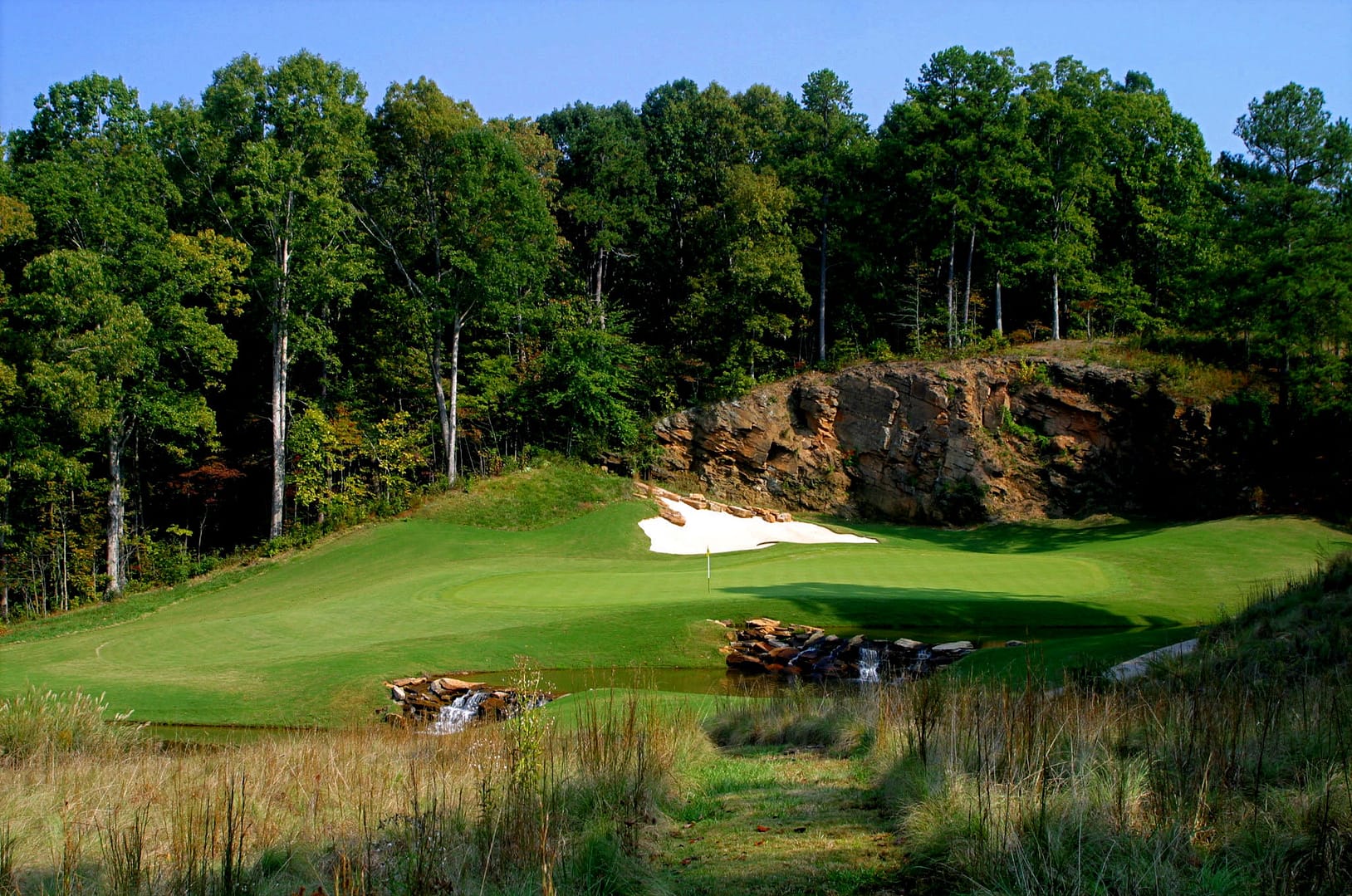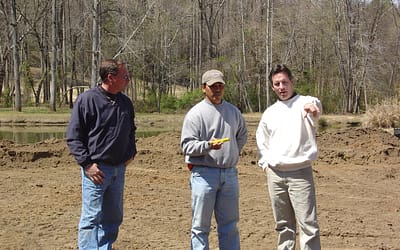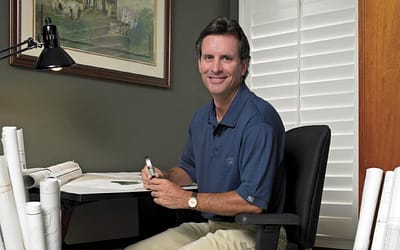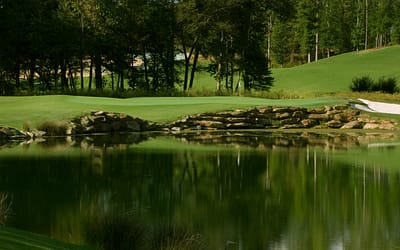Riley’s interpretive approach to course design and bold architecture provides a refreshing take on a classical aesthetic.
View the original article in PDF format.
By Derek Duncan, Golf Styles Atlanta
It’s pretty common knowledge that Robert Trent Jones designed one of Atlanta’s most prestigious golf temples when he built Peachtree Golf Club for Bobby Jones in 1947. Less commonly known, however, is that the course that now sits secluded off Ashford-Dunwoody Road in north Brookhaven was actually Jones’ second design for the club. His first plans for Peachtree were for a property just more than a mile to the southwest between Roxboro Road and North Druid Hills. When the larger Ashford Nursery site – where Peachtree now exists – became available, the Roxboro property was optioned to The Standard Club, whose members had begun to take an interest in a golf course of their own.
Though it wouldn’t be entirely accurate to say that The Standard Club got the “original” Peachtree Golf Club course, the membership did, in fact, use Jones’ design – with a few modifications – to build its course in 1947. For more than 35 years, The Standard Club members entertained and played golf there while property values in Buckhead and Brookhaven rose dramatically. By the early 1980s, the club was looking to do what so many other Atlanta clubs have done over the years: liquidate its in-town property to relocate somewhere north into the booming suburbs and closer to where the majority of its membership now lived.
In a deal with Technology Park/Atlanta in 1983, The Standard Club swapped its Brookhaven property for more than 300 acres of forested Land in Duluth near Johns Creek. There, Arthur Hills – who would later make a name for himself with his designs at nearby Golf Club of Georgia, a job he got based in part on his work for The Standard Club – built 18 holes that roamed quietly through the scenic property, the construction costs of which were funded by Technology Park/Atlanta as part of the deal.
The new Standard Club course, complemented by a prominent new clubhouse, tennis and racquet courts and swimming pool, opened in 1987. Using a minimum of bunkering and simple, angled green complexes as the principle defenses, Hills looped The Standard Club’s outward nine through the gentle hills of a higher section of the property before dropping it downs on the inward half to a flatter, lowland region along Johns Creek at the base of a bluff. Known for superlative conditions and the splendid, uncrowded setting (there are no homes or intrusions on the course), The Standard Club consistently ranked high among Atlanta-area club courses.
By 2004, however, the greens were beginning to show their age. To remedy several seasonally diseased complexes and persistent problems with the first bole caused by suspect construction (legends abound as to what objects were unearthed beneath the greens), the club decided to fund an extensive greens and bunkers renovation. SubAir Systems were installed to control moisture levels and monitor air flow beneath the putting surfaces. Atlanta-based architect Mike Riley orchestrated the greens renovation and when The Standard Club reopened in May 2005, members once again had a golf course to match the, well, elite standards of their historic club.
“It always had a good reputation with the land,” says Steve Roper, the club’s general manager. “The design is spread out over 300 acres and houses aren’t on top of you, so it always was a special property. And this club’s been around long enough that it’s known all over the country.”
While it may now be recognized nationwide for its golf and amenities, The Standard Club was originally chartered as a social organization known as the Concordia Chub in 1866, establishing it as Atlanta’s oldest still-existing club. Concordia’s founders were Jewish residents of German and Hungarian descent, and the club provided them a lively environment for socializing, meetings, arts and activities that preserved their Germanic heritage.
Almost from the beginning the Concordia Club was nomadic, moving from its original building on Whitehall Street to subsequent locations at Mitchell Street, Marietta Street and back co Mitchell Street. Though the original tie binding the members was a common German ancestry, by the turn of the century it was almost exclusively, their Jewish faith that brought members to the club.
A lull in membership prompted prominent Jewish businessmen and remaining Concordia members to reorganize as The Standard Club in 1904. The club grew but was still searching for a permanent home. In 1912, it hosted balls, recitals, dinners, card and even bowling games in a lavish residence on Washington Street. The club built a new Georgian clubhouse 17 years later on Ponce de Leon Boulevard, where activities such as swimming and tennis flourished. It was only natural that by 1946 one of the city’s most exclusive and esteemed clubs would become interested in golf, and it was then that the Roxboro Road property became available. The Standard Club’s history of growth and continual northward movement peaked with its final relocation to a 125,00 square-foot clubhouse in Duluth.
With its impressive facilities and the recently completed renovation, golf members have never had it so good. The club selected Riley to carry out the changes in large part because of the work he did renovating Atlanta Country Club’s greens, but also because they knew the course would receive his full attention. Riley, who lives nearby, spent nearly every construction day at the course, sometimes accompanied by his wife, making interpretive changes in the field while working and reworking greens and bunker complexes with his shapers.
The results are striking. By basically “re-imagining” the bunkering and green complex details, Riley has completely altered the character of The Standard Club, taking it from what was considered a solid if unspectacular design to one of the most vividly rendered courses in the region. He added approximately 30 bunkers to the course, eliminating Hills’ oval, flat-bottomed renditions and carving his own irregularly shaped hazards into the slopes. The rough edges and neutral colored sand matches the ruggedness of the site, and the shaping often bleeds on the back edge into the surrounding vegetation.
Working in the general footprints of Hills’ greens, Riley altered arid enlarged most putting surfaces while better integrating them into the surrounding slopes, allowing shoulders and ridges to slide from one elevation down onto the green surfaces to create contour from outward in. The artistic bunkering and tie-ins between greenscapes and their settings accentuate the site’s indigenous strengths while adding a new dimension of playability into the approach shots.
“Some of that contour is used to your advantage. If you can hit in the right spot, it will feed to the hole but if you hit it five feet to the right of that spat, it will feed away from the bole,” Riley says. “It will take a little while (for the members) to understand where they can use the green slopes to their advantage in certain pin locations. There are a lot of little things out there that will be discovered in time.”
Like most who have had the opportunity to play The Standard Club, Riley was impressed with the property the first time he saw it. “It was already there to begin with. The setting was very natural, and also in that natural setting was the tall grasses and ‘look’ of the golf course, which is completely different from anything in Atlanta. So that’s what I tried to play upon.”
In particular, Riley expanded the bunkering and use of the grasses around the bunkers to “make them more visually exciting so they added to the composition of the golf holes.” The renovation also included the softening of several extreme areas such as the tilted landing area of the par5 second and the high bank down the left side of the 520-yand seventh. A severe slope cutting across the fairways of the ninth and the 18th, which parallel each other, also was lowered, resulting in greater visibility – and drama – for the second shots.
Another focus of the renovation was to add strategic variety to the par 5s while making the four par 3s more attractive. The downhill 17th always has been among Atlanta’s favorite par 3s, but even it was improved by enlarging the water feature short of the green, reconfiguring the bunkering and clearing the vegetation from the natural escarpment of red rock behind it. Now, The Standard Club’s quartet of one-shot holes can be considered among the most memorable in the state.
“1 think they’re as strong as anywhere,” Riley says. “It turned out that I had great land to work with – all the things were there to create what we did. It just needed some tweaking.”
Like, for instance, the sixth hole. The wild broom sedge between the tee and green was partially cleared and in its place a rough and randomly vegetated wasteland was created, a scene that evokes images of Pine Valley. “You come around that comes and you’re like, ‘Holy cow, I didn’t know this was in Atlanta,” Riley says.
With Riley’s work complete and the sterling touch of superintendent Mike Brown, who came over from Hawk’s Ridge last November to oversee the grow-in, Atlanta’s oldest club has demonstrated a sudden, cutting-edge intuition. The members will reap the rewards, as The Standard Club transitions from one of Atlanta’s great social clubs into one of its great golf clubs.
The Standard Club
Duluth, Ga.
770.497.1920; standardclub.org
Par 72 – 7,075 yards – 75.0 – 145
Par 72 – 6,819 yards – 73.2 – 141
Par 72 – 6,338 yards – 70.9 – 135
Par 72 – 5,707 yards – 68.2 – 124
Par 72 – 5,040 yards – 65.2 – 116
Members: 460 golf members; prospective members must be sponsored by three members.
Initiation Fee: $25,000
Monthly Dues: $454
Amenities: 125,000-square-foot clubhouse with formal and informal dining rooms; ballroom; meeting rooms, locker rooms, 16 tennis courts (four indoor); squash, basketball and racquetball, weight room, pro shop.
In the same category





